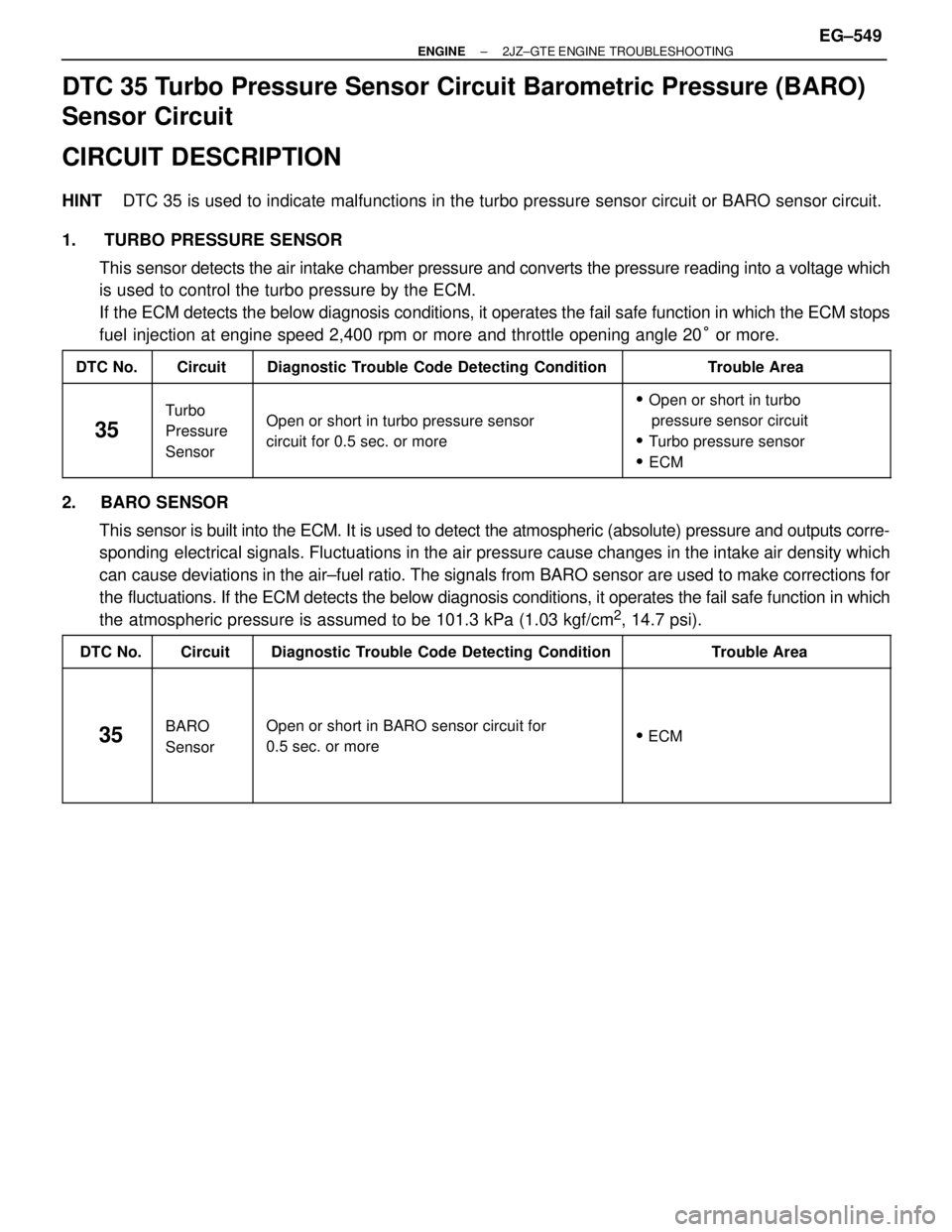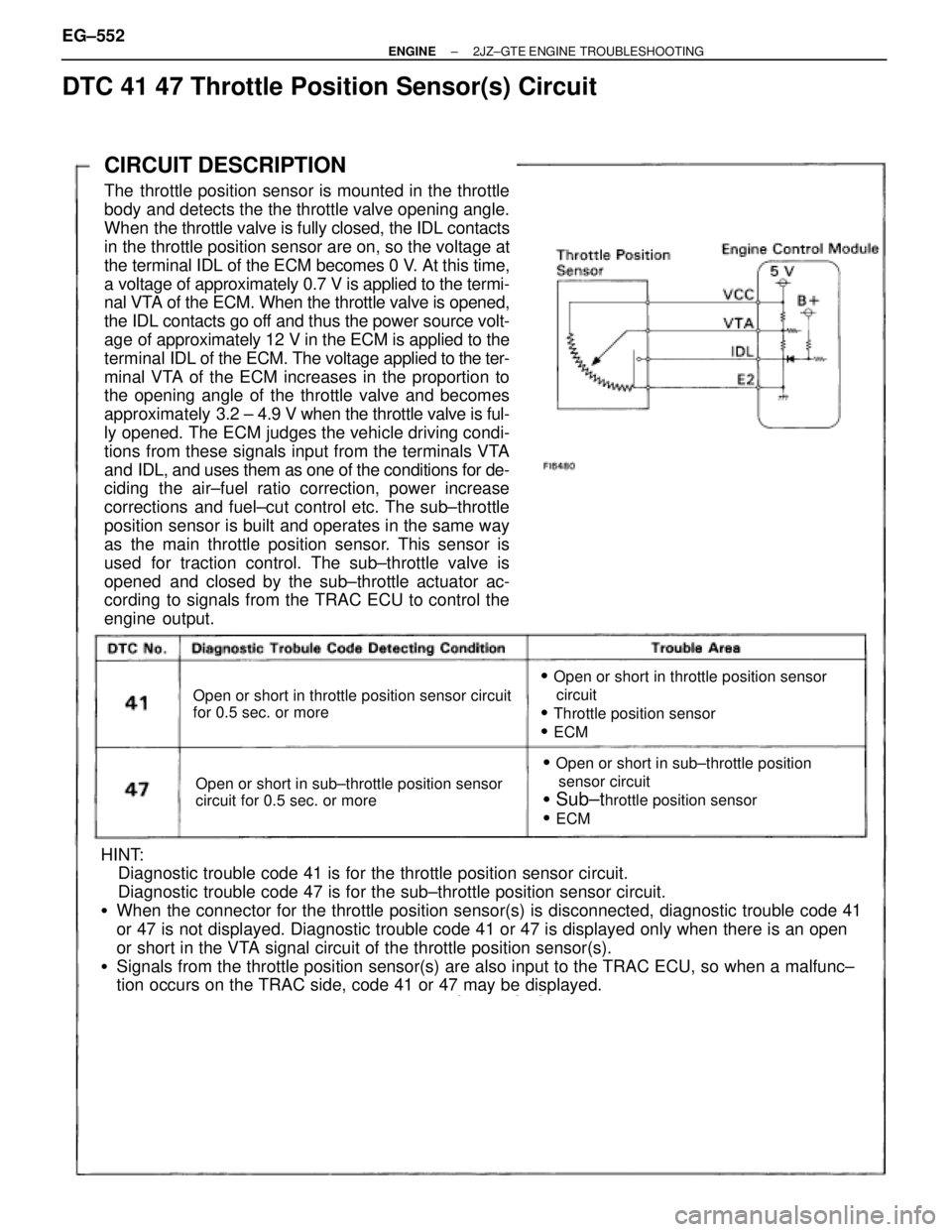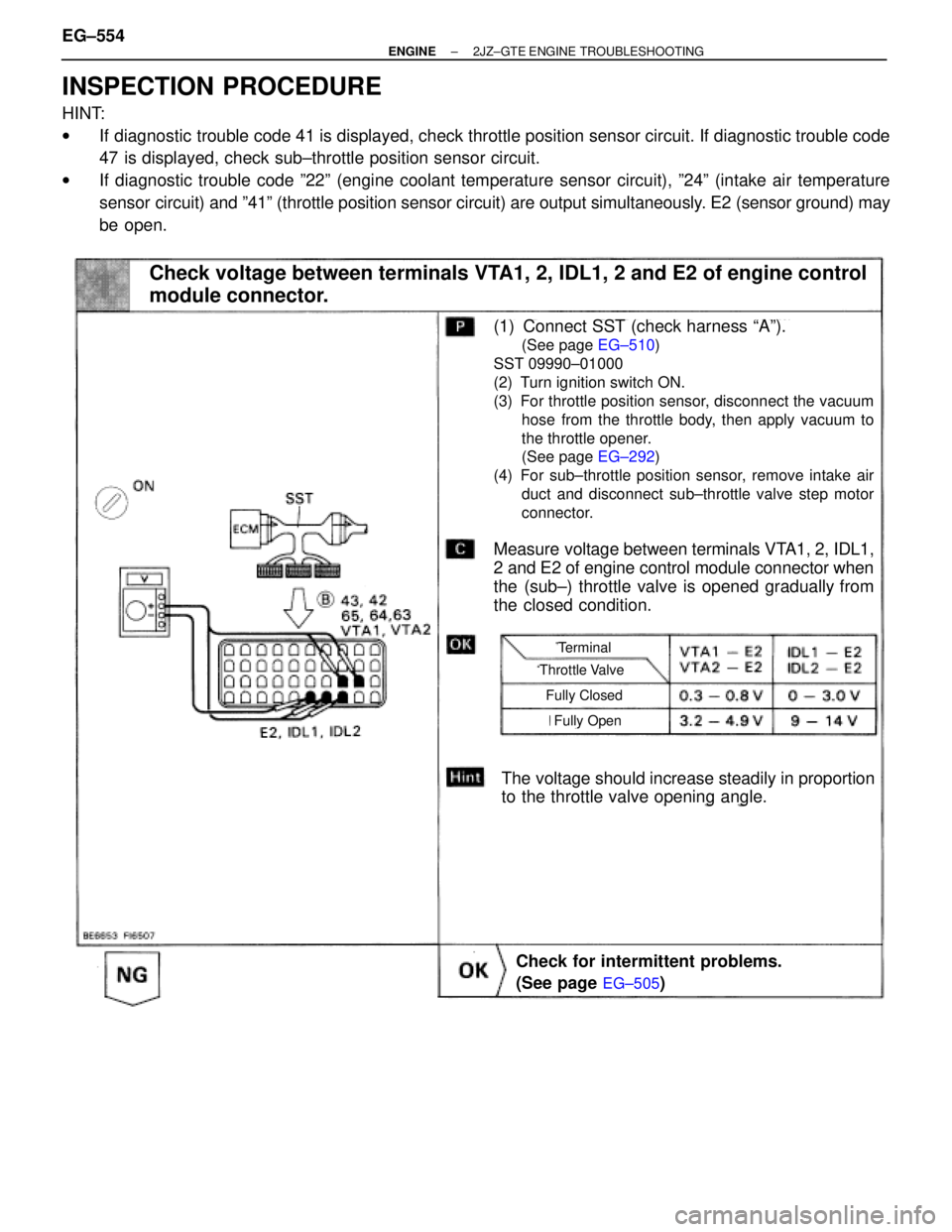Page 2054 of 2543
(1) Check actuator hose connection.
(2) Disconnect actuator hose.
(3) Using SST, apply pressure to the actuator.
SST 09992±00241
Waste gate valve operate smoothly.
Operation pressure:
119 kpa (1.2 kgf/cm
2, 17.3 psi) or less
Check operation of actuator.
Replace actuator.
INSPECTION PROCEDURE
± ENGINE2JZ±GTE ENGINE TROUBLESHOOTINGEG±547
Page 2055 of 2543
(See page EG±510)
(1) Remove VSV.
(2) Disconnect VSV connector.
Check operation of VSV for waste gate valve when
battery positive voltage is applied and released to
the VSV terminals.
Battery positivie voltage is applied:
Air from port E is flowing out through port F.
Battery positive voltage is applied:
Closed air passage from E to F.
Check voltage terminals PMC of engine control module connector and
body ground.
Check operation of VSV for waste gate valve.
Replace VSV for waste gate valve.
Check and repair harness and connector be-
tween VSV for waste gate valve and engine
control module.
(1) Connect SST (check harness ªAº).
(See page EG±510)
SST 09990±01000
(2) Turn ignition switch ON.
Measure voltage between terminals PMC of engine
control module and ground.
Voltage: 9 Ð 14 V
Check and replace enginie control module. EG±548
± ENGINE2JZ±GTE ENGINE TROUBLESHOOTING
Page 2056 of 2543

DTC 35 Turbo Pressure Sensor Circuit Barometric Pressure (BARO)
Sensor Circuit
CIRCUIT DESCRIPTION
HINT DTC 35 is used to indicate malfunctions in the turbo pressure sensor circuit or BARO sensor circuit.
1. TURBO PRESSURE SENSOR
This sensor detects the air intake chamber pressure and converts the pressure reading into a voltage which
is used to control the turbo pressure by the ECM.
If the ECM detects the below diagnosis conditions, it operates the fail safe function in which the ECM stops
fuel injection at engine speed 2,400 rpm or more and throttle opening angle 20° or more.
����� �
���� �����DTC No.����� �
���� �����Circuit����������������� �
���������������� �����������������Diagnostic Trouble Code Detecting Condition������������ �
����������� ������������Trouble Area
����� �
���� �
���� �
���� �����
35
����� �
���� �
���� �
���� �����
Turbo
Pressure
Sensor����������������� �
���������������� �
���������������� �
���������������� �����������������
Open or short in turbo pressure sensor
circuit for 0.5 sec. or more
������������ �
����������� �
����������� �
����������� ������������
�Open or short in turbo
pressure sensor circuit
�Turbo pressure sensor
�ECM
2. BARO SENSOR
This sensor is built into the ECM. It is used to detect the atmospheric (absolute) pressure and outputs corre-
sponding electrical signals. Fluctuations in the air pressure cause changes in the intake air density which
can cause deviations in the air±fuel ratio. The signals from BARO sensor are used to make corrections for
the fluctuations. If the ECM detects the below diagnosis conditions, it operates the fail safe function in which
the atmospheric pressure is assumed to be 101.3 kPa (1.03 kgf/cm
2, 14.7 psi).
����� �����DTC No.����� �����Circuit����������������� �����������������Diagnostic Trouble Code Detecting Condition������������ ������������Trouble Area����� �
���� �
���� �
���� �
���� �
���� �����
35
����� �
���� �
���� �
���� �
���� �
���� �����
BARO
Sensor
����������������� �
���������������� �
���������������� �
���������������� �
���������������� �
���������������� �����������������
Open or short in BARO sensor circuit for
0.5 sec. or more
������������ �
����������� �
����������� �
����������� �
����������� �
����������� ������������
� ECM
± ENGINE2JZ±GTE ENGINE TROUBLESHOOTINGEG±549
Page 2057 of 2543
(See page EG±510)(1) Connect SST (check harness ªAº).
(See page EG±510)
SST 09990±01000
(2) Turn ignition switch ON.
Measure voltage between terminals VCC and E1
of engine control module.
Voltage: 4.5 Ð 5.5 V
Check voltage between terminals VCC and E1 of engine control module
connector.
Check and replace engine control module.
INSPECTION PROCEDURE
HINT: DTC 35 indicates trouble in the BARO sensor circuit or turbo pressure sensor circuit. Because all func±
tions of the BARO sensor circuit are built into the ECM, it is not possible to check this circuit.
However, if no problem is found in the turbo pressure sensor circuit, it can be concluded that the problem
is in the BARO sensor circuit. EG±550
± ENGINE2JZ±GTE ENGINE TROUBLESHOOTING
Page 2058 of 2543
(See page IN±30).
Turn ignition switch ON.
Measure voltage between terminals PM1 and E2
of engine control module.
Voltage: 2.3 Ð 3.0 V
Check voltage between terminals PM1 and E2 of engine control module.
Check for open and short in harness and connector between engine control
module and turbo pressure sensor (See page
IN±30).
Check and replace engine control module.
Repair or replace harness or connector.
Replace turbo pressure sensor.
± ENGINE2JZ±GTE ENGINE TROUBLESHOOTINGEG±551
Page 2059 of 2543

CIRCUIT DESCRIPTION
The throttle position sensor is mounted in the throttle
body and detects the the throttle valve opening angle.
When the throttle valve is fully closed, the IDL contacts
in the throttle position sensor are on, so the voltage at
the terminal IDL of the ECM becomes 0 V. At this time,
a voltage of approximately 0.7 V is applied to the termi-
nal VTA of the ECM. When the throttle valve is opened,
the IDL contacts go off and thus the power source volt-
age of approximately 12 V in the ECM is applied to the
terminal IDL of the ECM. The voltage applied to the ter-
minal VTA of the ECM increases in the proportion to
the opening angle of the throttle valve and becomes
approximately 3.2 ± 4.9 V when the throttle valve is ful-
ly opened. The ECM judges the vehicle driving condi-
tions from these signals input from the terminals VTA
and IDL, and uses them as one of the conditions for de-
ciding the air±fuel ratio correction, power increase
corrections and fuel±cut control etc. The sub±throttle
position sensor is built and operates in the same way
as the main throttle position sensor. This sensor is
used for traction control. The sub±throttle valve is
opened and closed by the sub±throttle actuator ac-
cording to signals from the TRAC ECU to control the
engine output.
Open or short in throttle position sensor circuit
for 0.5 sec. or more
Open or short in sub±throttle position sensor
circuit for 0.5 sec. or more
�Open or short in throttle position sensor
circuit
�Throttle position sensor
�ECM
�Open or short in sub±throttle position
sensor circuit
�Sub±throttle position sensor
�ECM
HINT:
Diagnostic trouble code 41 is for the throttle position sensor circuit.
Diagnostic trouble code 47 is for the sub±throttle position sensor circuit.
�When the connector for the throttle position sensor(s) is disconnected, diagnostic trouble code 41
or 47 is not displayed. Diagnostic trouble code 41 or 47 is displayed only when there is an open
or short in the VTA signal circuit of the throttle position sensor(s).
�Signals from the throttle position sensor(s) are also input to the TRAC ECU, so when a malfunc±
tion occurs on the TRAC side, code 41 or 47 may be displayed.
DTC 41 47 Throttle Position Sensor(s) Circuit
EG±552± ENGINE2JZ±GTE ENGINE TROUBLESHOOTING
Page 2060 of 2543
± ENGINE2JZ±GTE ENGINE TROUBLESHOOTINGEG±553
Page 2061 of 2543

INSPECTION PROCEDURE
HINT:
wIf diagnostic trouble code 41 is displayed, check throttle position sensor circuit. If diagnostic trouble code
47 is displayed, check sub±throttle position sensor circuit.
wIf diagnostic trouble code º22º (engine coolant temperature sensor circuit), º24º (intake air temperature
sensor circuit) and º41º (throttle position sensor circuit) are output simultaneously. E2 (sensor ground) may
be open.
(See page EG±505)
(See page EG±510)
(See page EG±292)
Check voltage between terminals VTA1, 2, IDL1, 2 and E2 of engine control
module connector.
The voltage should increase steadily in proportion
to the throttle valve opening angle.
(1) Connect SST (check harness ªAº).
(See page EG±510)
SST 09990±01000
(2) Turn ignition switch ON.
(3) For throttle position sensor, disconnect the vacuum
hose from the throttle body, then apply vacuum to
the throttle opener.
(See page EG±292)
(4) For sub±throttle position sensor, remove intake air
duct and disconnect sub±throttle valve step motor
connector.
Measure voltage between terminals VTA1, 2, IDL1,
2 and E2 of engine control module connector when
the (sub±) throttle valve is opened gradually from
the closed condition.
Check for intermittent problems.
(See page
EG±505)
Throttle Valve
Terminal
Fully Closed
Fully Open
EG±554± ENGINE2JZ±GTE ENGINE TROUBLESHOOTING